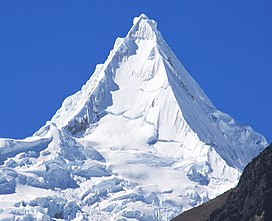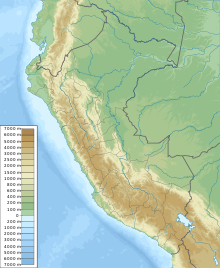
Alpamayo
| Alpamayo | |
|---|---|
 | |
| Highest point | |
| Elevation | 5,947 m (19,511 ft) |
| Prominence | 447 m (1,467 ft)[1] |
| Parent peak | Quitaraju |
| Coordinates | 08°52.75′S 77°39.22′W / 8.87917°S 77.65367°W |
| Naming | |
| Native name | Shuyturaju (Quechua) |
| Geography | |
| Location | Ancash, Peru |
| Parent range | Cordillera Blanca |
| Climbing | |
| First ascent | June 20, 1957, by Günter Hauser, Berhard Huhn and Horst Wiedmann. |
| Easiest route | Difficult snow/ice climb on SW face |
Alpamayo[2][3] (possibly from Quechua allpa earth, mayu river,[4] "earth river") or Shuyturaju[3] (possibly from Ancash Quechua huytu, shuytu oblong, slim and long, Quechua rahu snow, ice, mountain covered in snow)[5][6] is one of the most conspicuous peaks in the Cordillera Blanca of the Peruvian Andes. Alpamayo Creek originates northwest of it.[2]

The Alpamayo lies next to the slightly higher Quitaraju.

In July 1966, the German magazine "Alpinismus", published a photo of Alpamayo taken by American photographer Leigh Ortenburger accompanied by an article on a survey among mountaineering experts, who chose Alpamayo as "The Most Beautiful Mountain in the World".[7]

Climbing history and routes

Most popular routes start from the village of Caraz, on the north of the Cordillera Blanca. A French-Belgian expedition including George and Claude Kogan claimed to have made the first ascent in 1951. After studying the photos in George Kogan's book The Ascent of Alpamayo, the German team of G. Hauser, F. Knauss, B. Huhn & H. Wiedmann came to the conclusion that the 1951 team did not reach the actual summit, thereby making their ascent via the north ridge in 1957 the first.

The most common climbing route, known as the Ferrari route, is situated on the southwest face of the mountain. It was opened in 1975 by a group of Italian alpinists led by Casimiro Ferrari. It is considered a difficult climb, demanding good crampon and ice climbing technique. There are incomparable views of steep ice faces, penitentes, gigantic white walls and ridges like those of Huandoy Norte, Artesonraju and Huascaran Norte, similar to the finest of the Himalayan scenery. There are also at least six other alternative climbing routes, the second most popular being the Vasque-French route.

References
- ^ Peakbagger - Alpamayo
- ^ a b Peru 1:100 000, Corongo (18-h). IGN (Instituto Geográfico Nacional - Perú).
Nevado Alpamayo
- ^ a b "Nevado Alpamayo". Inventario Turístico del Perú (in Spanish). MINCETUR. Archived from the original on 10 June 2016. Retrieved 25 May 2016.
- ^ Teofilo Laime Ajacopa, Diccionario Bilingüe Iskay simipi yuyayk'ancha, La Paz, 2007 (Quechua-Spanish dictionary)
- ^ homepage.ntlworld.com/robert_beer Archived 2016-03-04 at the Wayback Machine Robert Beér, Armando Muyolema, Dr. Hernán S. Aguilar, Vocabulario comparativo, quechua ecuatoriano - quechua ancashino - castellano - English, Brighton 2006
- ^ "babylon.com". Archived from the original on 2014-12-29. Retrieved 2013-09-16.
- ^ Hibbert, Ian (2015). Alpamayo to Everest: It's Not About the Summit. Lulu Press. ISBN 9781483440736.
External links
- Alpamayo on Summitpost
- Expedition to Alpamayo - numerous photographs
- (in French) French Young Expedition to Alpamayo - photographs and good topo
- Landscapes of the Soul - An Australian climber's stunning photos of climbers on the Ferrari Route, and his 1987 ascent/descent of the more difficult French Route.
- Climbing Alpamayo 2007 ascent of the French Direct route, including many photographs
- (in French) French blog post on the ascent - photographs and ascension story
See what we do next...
OR
By submitting your email or phone number, you're giving mschf permission to send you email and/or recurring marketing texts. Data rates may apply. Text stop to cancel, help for help.
Success: You're subscribed now !

